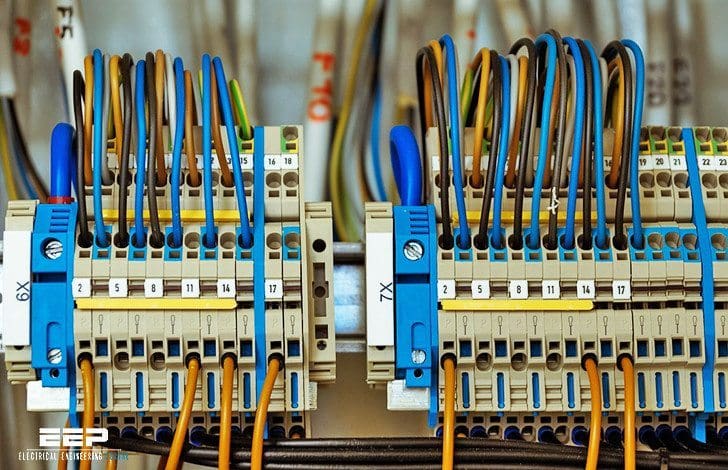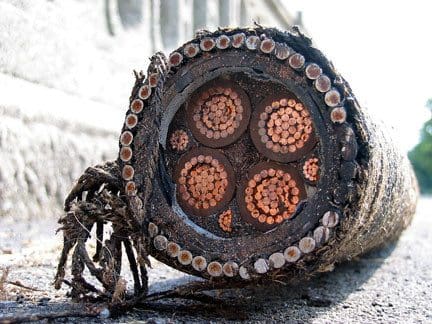Al or Cu conductor…
The conductivity of copper is 65% higher than that of aluminium which means that the conductor size of similarly rated cables is proportionately smaller. Correspondingly less expense is then incurred in providing for insulation, shielding and armouring the cables themselves. Transport of the less-bulky cables is easier and so is installation. In limited spaces in cable ducts, the smaller volume and better ductility of copper cables can have an even larger benefit.

Copper cables are easily jointed because copper does not form on its surface a tough, non-conducting oxide. The oxide film that does form is thin, strongly adherent and electrically conductive, causing few problems.
Cleaning and protection of copper is easy and if joints are made as recommended they will not deteriorate to any great extent with age, which saves on maintenance costs.


For the same nominal current rating, the cable with the aluminium conductor is significantly larger in diameter, carries a proportionally greater volume of insulation and is not so easily installed because of being less flexible. Aluminium is notoriously difficult to joint reliably. Table 1 compares aluminium and copper conductors for equivalent current rating.
Table 1 – Comparison between Copper and Aluminium Conductors in XLPE Insulated Steel- Wire Armoured Cables.
| Characteristic | Copper 300 m2 | Aluminium 500 m2 |
| Overall diameter (mm) | 66.5 | 83.9 |
| Minimum bending radius (mm) | 550 | 700 |
| Max DC resistance/km at 20o C (ohm) | 0.0601 | 0.0617 |
| Approx. voltage drop/A/m (mV) | 0.190 | 0.188 |
| Continuous current rating, drawn in to duct (amp) | 496 | 501 |
(Cable: to BS 5467 (& IEC 502) 4-core, stranded conductors, XLPE insulation, PVC bedding, steel wire armour, PVC oversheath, rated at 0.6/1.0 kV)
These notes have largely been derived from reference to BS 7450 which is identical to IEC 1059. Both of these give full details of the variables to be considered and the ways in which optimum cable size determinations can be made.
More about this is described in the following paragraphs.
Economic Selection of Cables for Industry
The function of a power cable is to distribute electric power as efficiently as possible from a source to a point of utilisation. Unfortunately, due to their electrical resistance, cables dissipate in the form of heat some of the power carried, so that 100% efficiency is not achieved.
An idea of the extent of this heat loss can be obtained from the comparison that modern cables are capable of operating at temperatures as high as those of central heating systems.
The energy lost by using cables at such temperatures has to be paid for and becomes a surcharge on the cost of operating whatever equipment is being supplied. This surcharge continues for the life of the process involved and into the future for any subsequent use of that circuit.
The cost of energy is an important component of industrial and commercial running costs and every effort should be made to contain it as much as possible. The environmental and conservational aspects of wasted energy are important factors, even though they may be partly subjective, and it is evident that pressures from this direction will increase.
It may be observed that heat losses from a cable go hand in hand with a lower voltage at its delivery end. This may impair the efficient operation of the supplied process, thus further degrading the cost efficiency of production.
It therefore makes good sense to adopt distribution designs which go as far as is practicable to reduce energy losses.
In theory it would be possible to reduce the lost power to a negligible amount by increasing the size of the cable; however, as this also increases the cost of the cable it tends to cancel the savings from better distribution efficiency and a compromise has to be struck.
The problem is to identify a conductor size which reduces the cost of the wasted power without incurring excessive cable costs. The basic approach to this problem was formulated by Lord Kelvin in 1881 and has been applied to numerous situations where cost (or weight) and efficiency need to be taken together to obtain an optimum solution.
Reference // Electrical energy efficiency of motors, cables, busbars and transformers











Please conform MCCB, TAP
Thanks for taking the time to put this article together for us engineers and technicians, good work!
Last paragraph:
” The basic approach to this problem was formulated by Lord Kelvin in 188129 and has been applied to numerous situations where cost (or weight) and efficiency need to be taken together to obtain an optimum solution.
Reference // Electrical energy efficiency of motors, cables, busbars and transformers
What would be the correct year please?
Would you be so kind as to state Lord Kelvin’s formula that you mention or a reference to undertake more research?
Regarding the reference given, would it be possible to supply more detail re the authors et al.
Thank You
Thanks for the sharp eye Derek :) You can get your copy of Electrical energy efficiency of motors, cables, busbars and transformers from:
https://electrical-engineering-portal.com/download-center/books-and-guides/electrical-engineering/electrical-energy-efficiency
and continue detailed study of this topic.
Dear Sir, Thank you for your effort to make other engineers and technicians to have the knowledge by sharing this.
I wish to know the same in detail and also i wish to know the cable routing design for a project. (Sewage Treatment Plant.
I am working as electrical engineer in a project company in Oman.
Hope I will get the details from you.
Thank you once again.